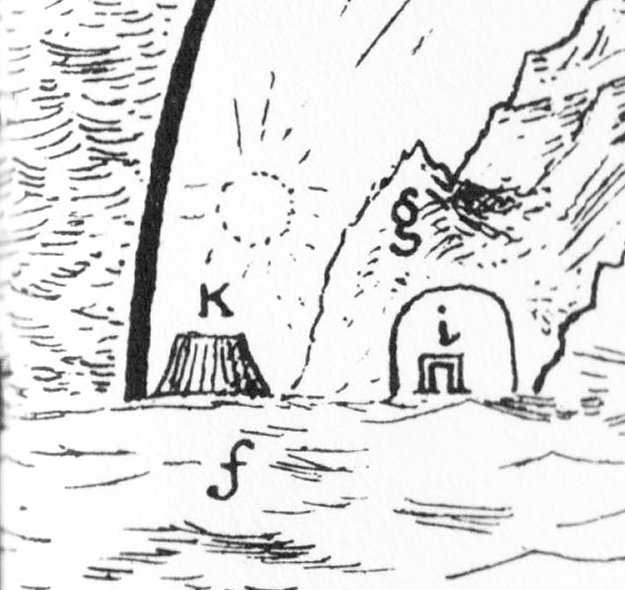|
TRANSLATIONS
With the unique Ka1-11, the missing 4 glyphs (the last of which should be number 16), and the unexpected pattern 9 - 25 (instead of 22 - 25), the simple but marvellous unique Pythagorean triangle presumably has been alluded to:
Number 25 (Ka2-1) has a moon sign not only at 22 but also at 29. We should look again at the earlier 22 - 25 patterns to see if possibly also they have something in common at position 29:
Here the 29th position is occupied by a 'midnight henua'. A long sequence of glyph triplets is evident. This time I imagine the week should be read according to the triplet pattern, with Saturn, Sun and Moon in the first triplet (the primary time givers in the sky), with Mars alone in the 2nd triplet, and with Mercury, Jupiter, and Venus forming the last triplet. The central position of Mars, bridging sky and earth, and dispersing the darkness (29), changes the normal 7 into 9. In Gb2-4 we can imagine the picture of a metor blazing down from the sky to the earth, bringing the light which at the bottom of Gb2-5 has dispersed the darkness. Did once upon a time ancient and curious Man got hold of fire from the impact of a meteor? But at the same time the basic picture in Gb2-4 is that of a growing seed. Without light there cannot be any growth. The theme is then followed by the logical appearance of Sirius and a canoe (with 2 * 12 = 24, thereby - maybe - closing a cycle beginning with the same canoe at Gb1-24):
I have seen a similarity between the appearance of Sirius early in the 2nd half of the G text and the appearance of Sun early in the 1st half of the G text. I have also seen a similarity between the dark time prior to the appearance of Sirius and the dark time prior to the appearance of Sun. Mars has a key position in bringing 'fire' down to the earth, i.e. to bring Sun respectively Sirius to the day respectively night sky. With this great mythic structure in mind, the time in the 'water' (from winter solstice to the reappearance of Sun) should be described at the beginning of the texts in G and K. The 2nd half of the G text should similarly describe the time of the 'water' from summer solstice to the reappearance of Sirius. We may here have a key to unlock the secret if the K text covers only the 1st half of the year or can be read also for the 2nd half of the year. The 'water' should make us think about the basic mythical theme of the inundation of the world and about Noah and the Ark. I suggest the canoes in the nighttime calendars, which appear after midnight, represent the 'Ark', in Polynesian fashion depicted as a double-canoe:
Although, of course, the Polynesian 'Ark' must be a double-canoe, the original once was in the form of a cube: "Utnapishtim is spry enough to tell in great detail the story of the Deluge. He tells how Enki-Ea has warned him of Enlil's decision to wipe out mankind, and instructed him to build the Ark, without telling others of the impending danger. 'Thus shalt thou say to them: (I will ... go) down to the apsu and dwell with Ea, my (lor)d.' He describes with great care the building and caulking of the ship, six decks, one iku (acre) the floor space, as much for each side, so that it was a perfect cube, exactly as Ea had ordered him to do. This measure '1-iku' is the name of the Pegasus square, and the name of the temple of Marduk in Babylon, as is known from the New Year's Ritual at Babylon, where it is said: 'Iku-star, Esagil, image of heaven and earth'." (Hamlet's Mill) Marduk was he who slashed the 'night monster' in two parts, we know, just as the 'midnight henua' divides the night calendar in two parts:
Midnight corresponds to winter solstice, and I have written about the spinning top and the two points of hazard during the old Babylonian year:
There are two hazardous places during the year, two places down in the 'water'. The 'sea' is never to be trusted. I suspect the Polynesian word noa to be fundamentally the same as Noah. It would take much effort and time to 'prove' this suggestion, but I must mention it here because the technical term 'perpendicular' (needed to create the squares for constructing a cube) is tu'u noa (where tu'u means to stand erect). To measure out a square (and then a cube) in order to construct the necessary ship needed to survive the Deluge you need a Pythagorean triangle, and that is why we see such a one in Ka1-11. It is the Great such triangle, with 3 * 3 + 4 * 4 = 5 * 5:
The very special Ka1-20 may depict how the whole sky is inundated. The 20-glyph long sequence above evidently should be divided into 5 quartets of glyphs, which will define 8 prior glyphs:
These 8 surely, though, belong to the story. Ka1-7--8 are similar to Ka1-9--10 (and these 4 glyphs are important, as judged by the appearance of several parallels in other rongorongo texts). Ka1-3 and Ka1-5 must be telling something about 'fire'. Therefore, the number of the game is 24 + 4 = 28. |
|||||||||||||||||||||||||||||||||||||||||||||||||||||||||||||||||||||||||||||||||||||||||||||||||||||||||||||||||||||||||||||||||||||||||||||||||||||||||||||||||||||||||||||||||||||||||||||||


















